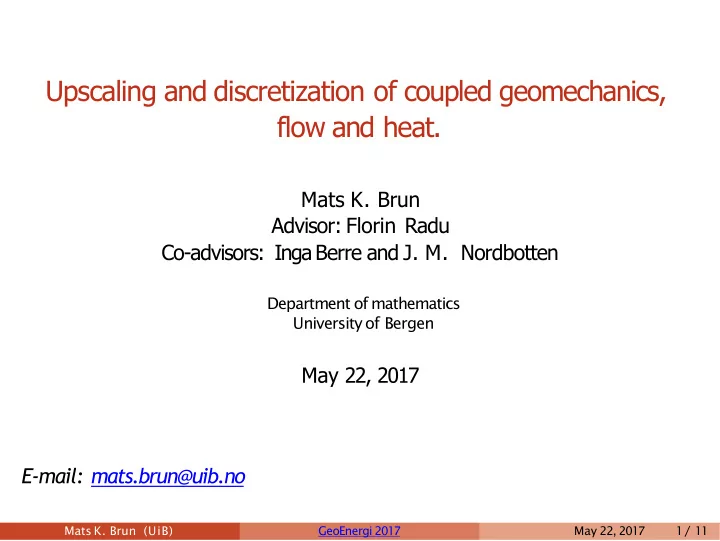

Upscaling and discretization of coupled geomechanics, flow and heat. Mats K. Brun Advisor: Florin Radu Co-advisors: Inga Berre and J. M. Nordbotten Department of mathematics University of Bergen May 22, 2017 E-mail: mats.brun@uib.no Mats K. Brun (UiB) GeoEnergi 2017 May 22, 2017 1/ 11
My background Bachelors degree in physics from UiB. Masters degree in applied and computational mathematics from UiB. Currently PhD candidate with porous media group at UiB, involved with the TheMSES research project (Thermo Mechanical Subsurface Energy Storage). Figure: University of Bergen. Photo: UiB.no Mats K. Brun (UiB) GeoEnergi 2017 May 22, 2017 2/ 11
The TheMSES project Intermittent renewable energy sources such as wind and solar power have a great variability over time, while the industrial demand as well as household consumption remains more or less fixed. Figure: Power generating wind turbines. Photo: iStock → need for deployment of scalable solutions to mitigate the production-consumption gap. Mats K. Brun (UiB) GeoEnergi 2017 May 22, 2017 3/ 11
The TheMSES project One such solution is injection of hot fluids at elevated pressure into geological permeable layers, such as saline aquifers or depleted oil and gas reservoirs. Figure: Diagram of geothermal energy storage. Photo: LifeFreeEnergy.com Upon extraction, both thermal and mechanical energy may be recovered. Mats K. Brun (UiB) GeoEnergi 2017 May 22, 2017 4/ 11
The TheMSES project The main objective of the TheMSES project is to provide the mathematical models and simulation technology required to assess thermo-mechanical energy storage on a large scale in the context of intermittent renewable energy. Figure: Trapped oil (yellow) in water (blue) wet porous media, imaged by X-ray -CT. Photo: UniPetroSol.com Mats K. Brun (UiB) GeoEnergi 2017 May 22, 2017 5/ 11
Homogenization and porous media Porous media consists of a grain space and a (connected) void space in which fluid can flow, but when large scales are considered it is neither possible nor necessary to take this complicated structure into account, and instead one models the porous medium as a uniform material. Figure: Macro/micro scale diagram. Picture: Larsson et al. 2016 Such models are usually obtained empirically, but can also be derived using homogenization . Mats K. Brun (UiB) GeoEnergi 2017 May 22, 2017 6/ 11
Homogenization and porous media Homogenization is a mathematical tool for upscaling/averaging models (PDE’s) posed in complex domains or involving rapid oscillatory characteristics. Example: Consider a Porous material saturated by water. Within each pore the flow is governed by the Navier-Stokes system. When averaged over a REV, fluid velocity defined at each point and is given by Darcy’s law. Figure: Diagram of Darcy’s experiment (1856). Picture: Philip B. Bedient Mats K. Brun (UiB) GeoEnergi 2017 May 22, 2017 7/ 11
.. In relation to TheMSES To accommodate TheMSES, effects of geochemistry and heat must also be taken into account, as rock dissolution and thermal strains at the micro-scale may influence the effective properties of the porous medium. Probably possible to obtain such models empirically, but that would require extensive laboratory work. → Better to use homogenization! Mats K. Brun (UiB) GeoEnergi 2017 May 22, 2017 8/ 11
Progress so far My plan: use homogenization to derive an effective model for the coupling of mechanics, flow, geochemistry and heat. So far: derived an effective model for the coupling of mechanics, flow and heat. Currently working on the implementation. Mats K. Brun (UiB) GeoEnergi 2017 May 22, 2017 9/ 11
Thank you for your attention! Mats K. Brun (UiB) GeoEnergi 2017 May 22, 2017 10 / 11
Recommend
More recommend